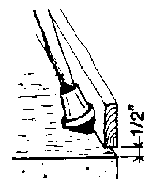Next Page |
Previous Page |
Index
Rampway Widths and Running Surface
Features
Running
surface widths can range from 36" to 48", depending
on the personal assistance or mobility equipment involved. 36"
may be appropriate for someone walking or using a cane, crutches,
or a walker. (32" may be appropriate for persons who need
to lean on both railings when moving.) 42" to 48" is
appropriate for someone using a wheelchair, or where a person
can walk with assistance at the side.
Surface height changes from
the doorsill and top landing to the bottom landing shouldn't vary
more than 1/2". Higher bumps can abruptly stop a wheelchair,
or trip people walking, particularly those with an irregular gait.
All ramp runs and landings
must be level from side to side. A cross slope (slope perpendicular
to the direction of travel) can upset a person's balance and require
more strength and effort on the person's "downhill"
side. Even the almost unnoticeable slope (1:96) built into public
sidewalks to aid with water runoff can be tiring for a wheelchair
user to negotiate.
It is advisable for ramps
to have an "anti-slip" running surface; depending on
local building code enforcement, this may be a requirement. On
wooden ramps, treatments that are used include commercially-available
"grit" tapes, strips of rolled roofing or shingling,
or laying down coats of polyurethane into which sand is sprinkled.
For concrete ramps, the surface can be brushed with a broom before
it hardens to create a rough texture.
Safety Features: Installation
of safety features including handrails, guardrails, "crutch
stops", guttering and sheltering should also be considered
for a rampbuilding project.
Handrails should account for
variables including a person's height, arm and hand strength,
how the rails are used, and any local building code requirements
that may apply. For example, standing users who lean on rails
for support with arms extended often need a very different rail
height than that used by persons propelling a wheelchair by pulling
along the rails. 31 " to 34" is the typical height
range, and the rails should be capable of supporting a 250 lb.
load at any point along the length. The diameter should be no
more than 1 1/2", and may need to be smaller for children
or adults with impaired grip strength. The preferred material
is wood. Metal piping is sometimes used, but may present a problem
for exposed skin in the wintertime.
 Guardrails and edging called
"crutch stops" or "bump boards" are also good
safety factors that keep users from slipping off the side of a
ramp or landing. Guardrails are mounted along the structure's
perimeter, usually at a seated person's knee height-18" to
20" or so. "Crutch stops" are curbing mounted on,
or a few inches above, the surface of the structure's perimeter.
Guardrails and edging called
"crutch stops" or "bump boards" are also good
safety factors that keep users from slipping off the side of a
ramp or landing. Guardrails are mounted along the structure's
perimeter, usually at a seated person's knee height-18" to
20" or so. "Crutch stops" are curbing mounted on,
or a few inches above, the surface of the structure's perimeter.
Two additional safety features
to consider are guttering and sheltering. If not present, roof
gutters may be advisable for ramps running close to a home to
handle water runoff that may create slipping hazards. In cases
where the person's mobility is severely restricted, some form
of rampway sheltering may also need to be considered. Depending
on siting and home roofline, one strategy for ramps hugging a
house is to build a small extension off the roof. Support for
the lower edge can be provided by extending the ramp's posting
vertically.
Next Page |
Previous Page |
Index
 Guardrails and edging called
"crutch stops" or "bump boards" are also good
safety factors that keep users from slipping off the side of a
ramp or landing. Guardrails are mounted along the structure's
perimeter, usually at a seated person's knee height-18" to
20" or so. "Crutch stops" are curbing mounted on,
or a few inches above, the surface of the structure's perimeter.
Guardrails and edging called
"crutch stops" or "bump boards" are also good
safety factors that keep users from slipping off the side of a
ramp or landing. Guardrails are mounted along the structure's
perimeter, usually at a seated person's knee height-18" to
20" or so. "Crutch stops" are curbing mounted on,
or a few inches above, the surface of the structure's perimeter.